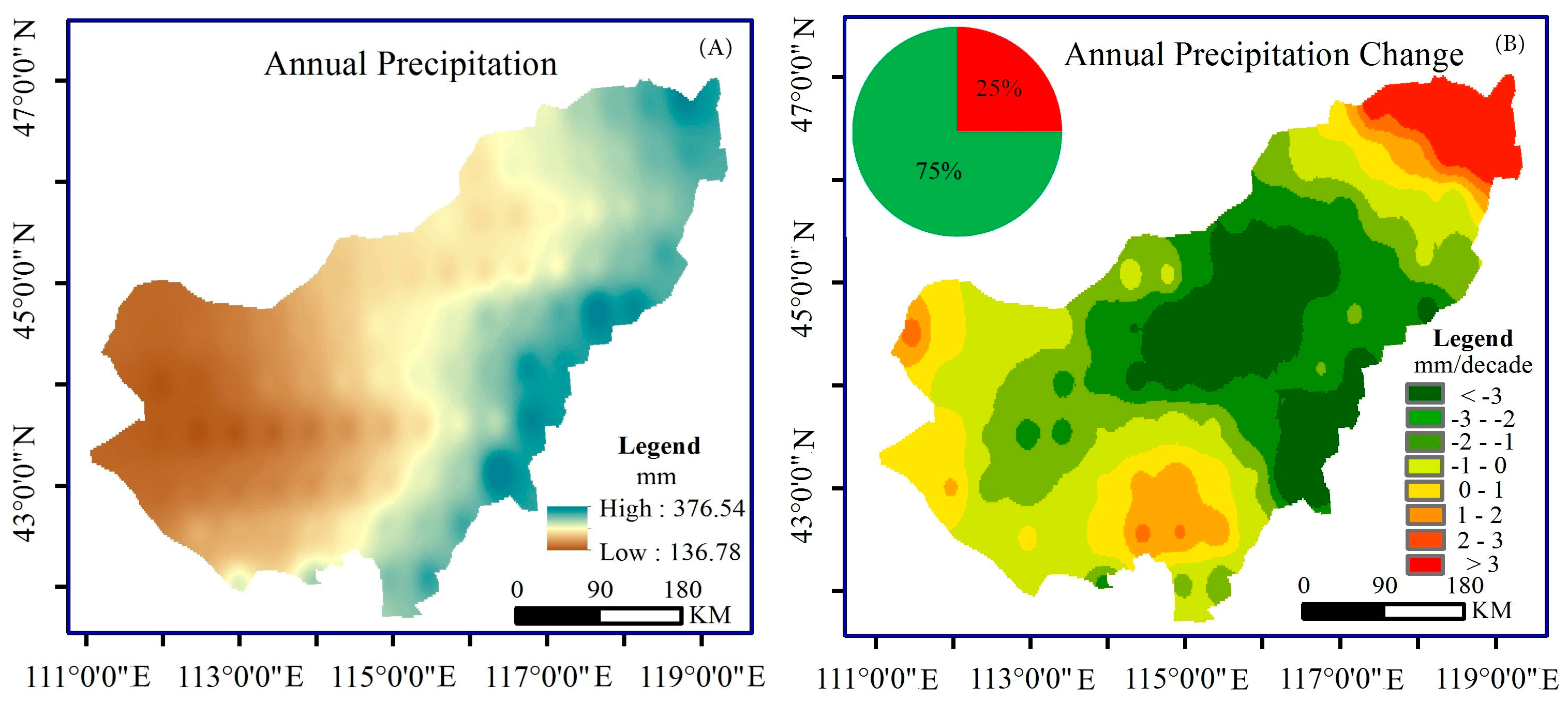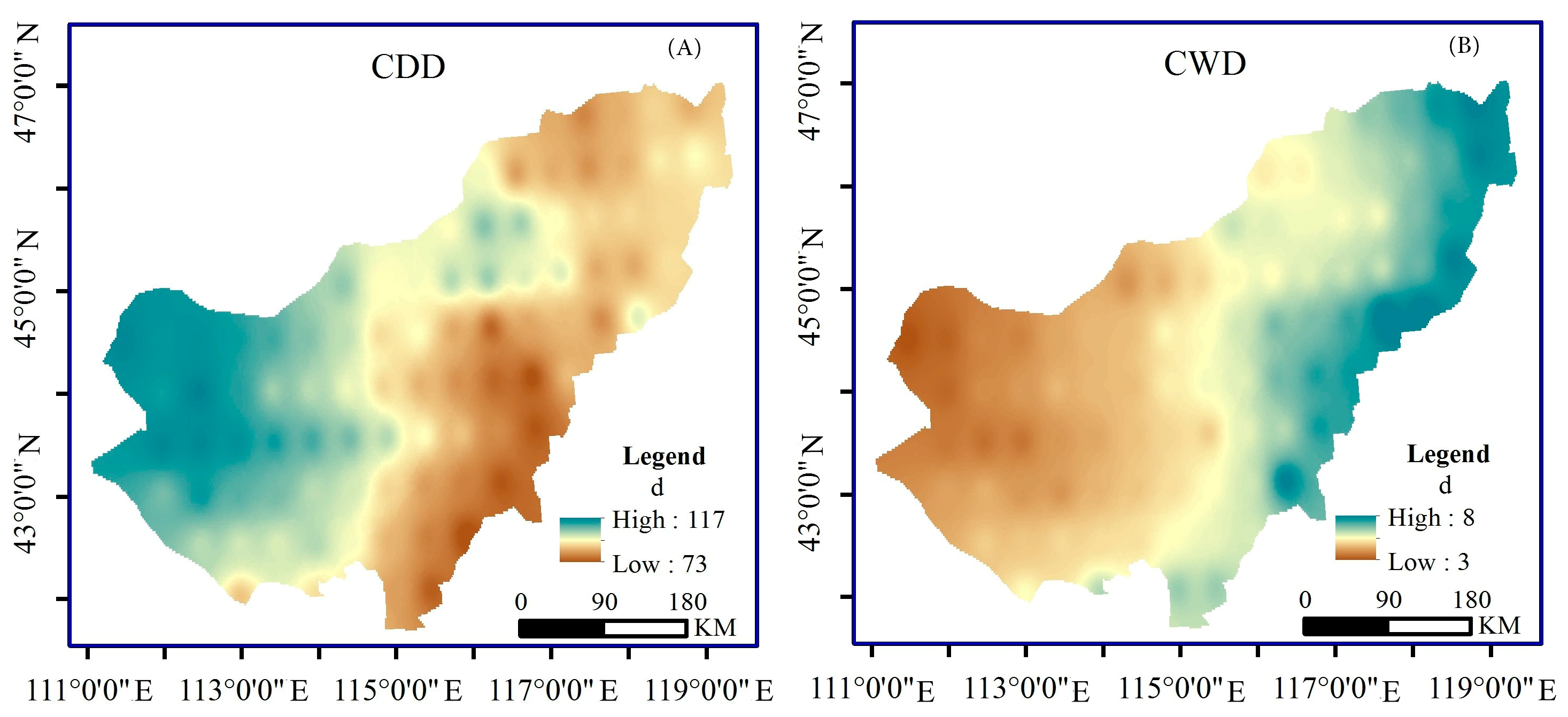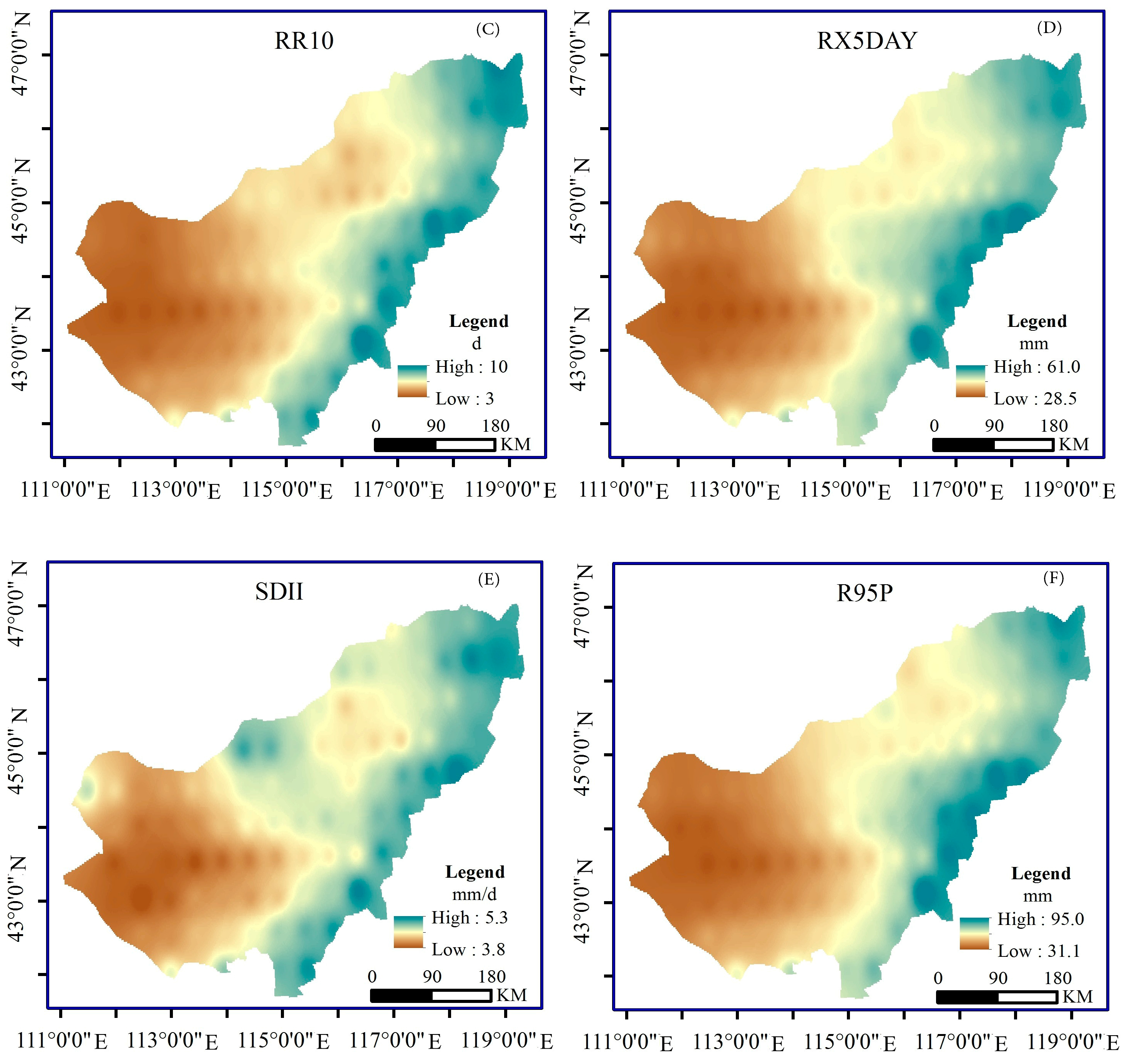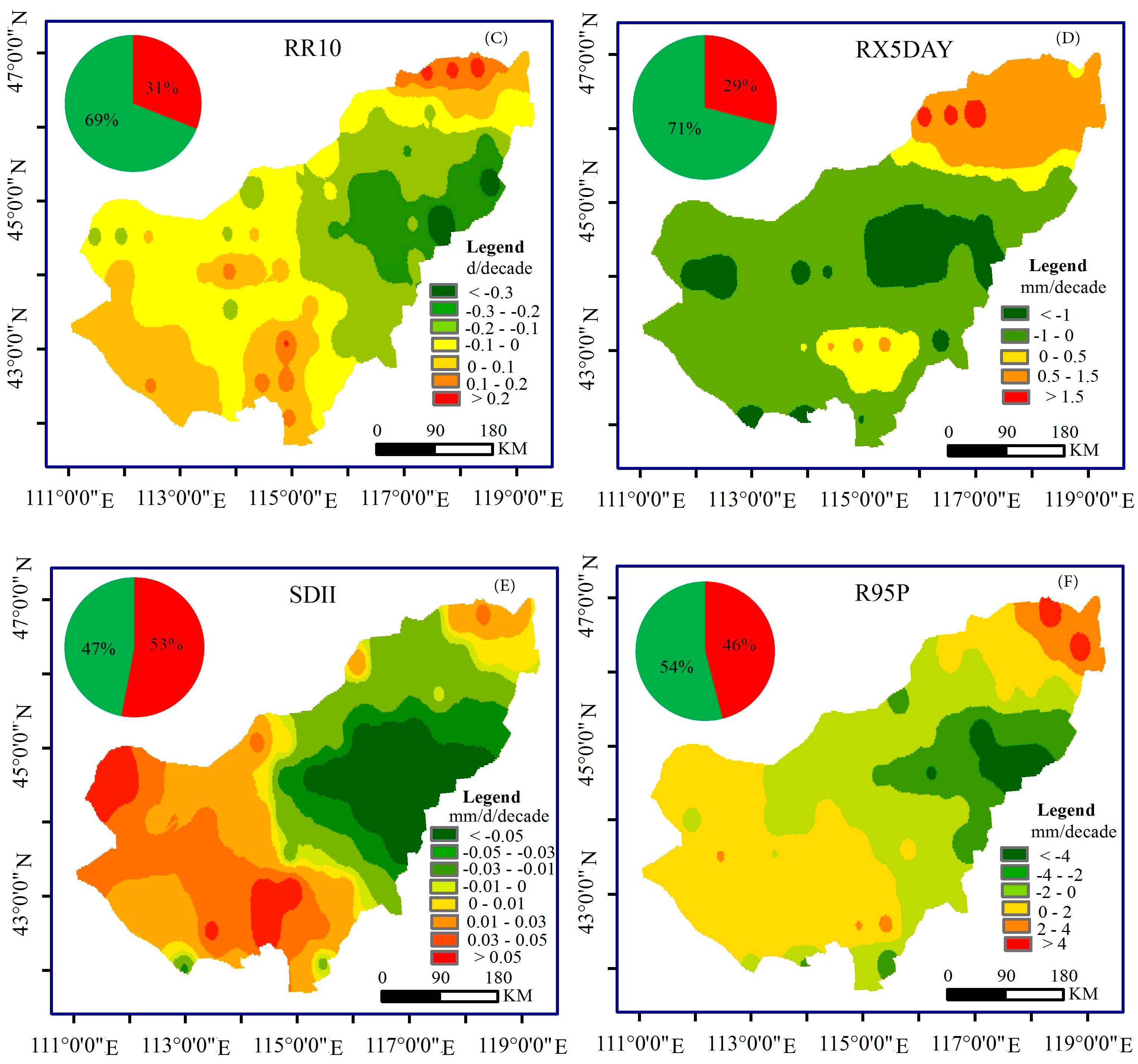3.1. Precipitation Change Background
As shown in
Figure 2A, we observe that the bias between the IDW interpolated data and the observed data at Erlianhaote station is 17.33%, the highest value among the stations. Meanwhile, the absolute value of the remaining station bias are all less than 15%, of which the vast majority are less than 10%, accounting for 73.33% of the total stations, the accuracy can meet the requirement of such research. In addition, there is a very good linear relationship between the station data and the IDW interpolated data (R
2 = 0.98), passed the significance test on the level of 0.0001. Furthermore, the slope of this linear fitting equation reaches 1.08, which is in close proximity to 1.00 (
Figure 2B). Therefore, the gridded dataset can reflect the spatiotemporal patterns of precipitation distributions in study area.
The spatial pattern of the annual precipitation in the study area from 1961–2015 exhibits the obvious feature of “high in the northeast and low in the southwest”, and which gradually declines from 376.54 mm in the eastern region to 136.78 mm in the western region. The difference between the annual precipitation in the eastern and western is as high as 240 mm (
Figure 3A). Moreover, the precipitation in northeast region exhibits an upward trend with a velocity in excess of 3 mm in a decade (mm·decade
−1), but the region with an increasing trend of precipitation only accounts for 25% of the total area. The remaining 75% is the area where shows an insignificant decreasing trend, mainly being located in the central of the study area (
Figure 3B).
3.2. Spatiotemporal Variations in Extreme Precipitation Indices
The spatial distributions of the extreme precipitation indices for the eastern part of inland river basin of Inner Mongolian Plateau from 1961–2015 are shown in
Figure 4. The consecutive dry days (CDD) are gradually alleviated from southwest to northeast, and the CDD can reach up to 117 days in arid zone of the basin (
Figure 4A). Opposite to the spatial variation trend of CDD, the other five extreme indices exhibit the distribution features of “high in the northeast and low in the southwest”. Particularly, the annual average of consecutive wet days (CWD) is 3–8 days, which is generally small and the maximum value appears in the northeast of the study area (
Figure 4B). Similarly, the number of days with heavy precipitation (RR10) is range between 3 and 10 days, and heavy precipitation is also mainly occurs in the eastern region (
Figure 4C). Regarding the precipitation amount, maximum precipitation over five days (RX5DAY) and heavy precipitation (R95P) decrease gradually from 61.0 mm and 95.0 mm in the northeastern to 28.5 mm and 31.1 mm in the southwestern, respectively (
Figure 4D–F). In addition, the average value of R95P is generally higher than RX5DAY. We can find from the SDII diagram that the average precipitation intensity ranges from 3.8 to 5.3 mm·day
−1, and the spatial difference is not so large (
Figure 4E). Except for CDD, the spatial variations of the other five extreme precipitation indices are similar to the variation of the annual precipitation.
The inter-annual variations of different extreme indices were evaluated by using the average of the values on all the grids. The inter-annual variations were not obvious. In particular, the indices that characterize the heavy precipitation amount (RX5DAY and R95P) exhibit a weak upward trend (
Figure 5D–F), and the other indices exhibit a downward trend. In addition, we can also see from the smoothing average curve of five years that SDII was in a stable fluctuation period in the 1970s and increased with a relatively large magnitude from the end of the 1980s to the end of the 1990s. After the end of the 1990s, SDII was again in a stage of stable fluctuation (
Figure 5E), which is similar to the variation trend of RR10 (
Figure 5C), RX5DAY, and R95P. Both CDD and CWD have always been in a downward stage with fluctuations (
Figure 5A,B).
The spatial distributions of the variation magnitude for different extreme indices during the observation period is shown in
Figure 6, from which we can see that CDD and CWD are dominated by declination, both of which account for 91% of the study area, the difference is that the former has a significant downward area of 17.28%, while the latter with a significant decreasing trend account for 16% (at a significance level of
α = 0.1), where mainly located in the south of the study area (
Figure 6A,B). We can see from the (
Figure 6C) that the variation magnitude of the number of days with heavy precipitation in our study area is relatively small, and does not exceed 0.3 mm·decade
−1. Similarly, the variation of RX5DAY is also relatively weak, the region exhibit a downward trend accounts for 29% of the study area (
Figure 6D).
In spite of this, the region of SDII shows an upward trend (53%), the area of which exceed the downward area (47%), and the variation magnitude is extremely small, therefore, the performance of the precipitation intensity exhibit the downward trend (
Figure 6E). The spatial distribution of the variation magnitude for R95P is dominated by the decreasing trend, being mainly located in the central of study area, which accounts for 54% of the research area, in addition, the magnitude of this increase in the northeastern area is 2–6 mm·decade
−1, which is greater than 0–2 mm·decade
−1 in the southwestern area (
Figure 6F). None of the other four indices exhibits a significant changing trend expect for CDD and CWD.
3.3. Factor Analysis of Extreme Precipitation Indices
After analyzing the annual precipitation and the six extreme indices by principal component analysis, the results show that the first principal component accounts for 61.34% of the total variance, which included almost all of the indices except for CDD and CWD, and the loads of the component indices are all exceed 0.80, particularly, R95P has a maximum load of 0.96, which reflects that R95P has the indicative function for the whole heavy rainfall regime. In addition, the variance contribution rate of the second component is 16.25%, and the loads of CDD and CWD are relatively high, are 0.64 and −0.72, respectively. Therefore, this kind of extreme event can be defined as the drought regime, which is characterized by CDD (
Table 4).
The Pearson correlation coefficients between annual precipitation and extreme indices are shown in
Table 5 to verify the relationships between them. In addition to CDD, the other five extreme indices have positive correlations with the annual precipitation and their correlation coefficients are statistically significant at the 0.01 level. The negative correlation coefficient between CDD and CWD reaches 0.60 (at a significance level of
α = 0.05), but the correlation between this two extreme indices and the other four indices is relatively poor. When comparing the behavior of the remaining four extreme indices, R95P has the strongest correlations with the other three indices, and all of the correlations coefficients fell in the confidence interval under the 99% confidence level, which further validates the results in
Table 4. To some extent, CDD and R95P can characterize the two kinds of extreme precipitation events we defined as the drought event and the heavy rainfall event well, and the two kinds of extreme events form the extreme precipitation events in our study.
3.4. Response of the Extreme Precipitation Indices to ENSO Event
The Pearson correlation coefficients between the six extreme precipitation indices and the two ENSO indices were calculated in
Table 6, and there are obvious differences between them. CDD has a negative correlation with SSTA from January to June, and has positive correlation with it from July to December. However, in terms of the correlation with SSTA, the other five indices have almost the opposite features with CDD at monthly scale. Including the positive correlations of RR10 and SDII with SSTA from January to April, which are statistically significant at the 0.05 level, and the negative correlations from June to December. In addition, R95P is also showing a significant negative correlation with SSTA (at a significance level of
α = 0.1) from September to December. Furthermore, the correlation relationship between each extreme index and SOI is opposite to the relationship of which with SSTA, except in May, respectively. It means that if the extreme index showing a negative (positive) correlation with SSTA, it will appear a positive (negative) correlation with SOI at the same month. Both RR10 and SDII are closely related with SOI as well (at a significance level of
α = 0.05) from January to April. In general, RR10, SDII, and R95P are particularly sensitive to ENSO in our study area.
Table 7 shows how the extreme precipitation indices in a specific ENSO period deviate from the normal period in detail. The values were calculated by the average of the indices that correspond with the years of the specific ENSO category. The average consecutive dry days in moderate El Niño years are as many as 117 days, 21 days more than which in normal years, while there are only 87 days in strong El Niño years, moreover, no matter the moderate or strong La Niña events happened, the values of CDD are always decreased. The situation of CDD is similar to that of CWD.
From different values of RR10 in the five periods, we can find that there is little difference between each other, which indicates that ENSO events have limited influence on RR10 in study area. For RX5DAY, the strong El Niño events reduce the maximum precipitation over five days by 4.66 mm, while the moderate El Niño events increase it by 4.93 mm. Additionally, approximately 2.20 mm is increased by the occurrence of both two categories La Niña events compared to the normal years for RX5DAY. The influence of different ENSO periods on RX5DAY is almost identical with R95P, the only difference is the amplitudes of R95P between ENSO years and normal years are relatively larger than RX5DAY. The maximum value of precipitation intensity appears in moderate El Niño years, and SDII in strong La Niña years is also greater than in normal years. However, during strong El Niño years and moderate La Niña years, the values are both smaller than in normal years.
In summary, the values of extreme precipitation indices in moderate El Niño are usually greater than of which in normal years, but in strong El Niño years, these values are always the smallest. The both two kinds of La Niña events may decrease the values of CDD and CWD, but increase the values of RX5DAY and R95P.













